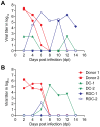The potential of avian H1N1 influenza A viruses to replicate and cause disease in mammalian models
- PMID: 22848544
- PMCID: PMC3404991
- DOI: 10.1371/journal.pone.0041609
The potential of avian H1N1 influenza A viruses to replicate and cause disease in mammalian models
Abstract
H1N1 viruses in which all gene segments are of avian origin are the most frequent cause of influenza pandemics in humans; therefore, we examined the disease-causing potential of 31 avian H1N1 isolates of American lineage in DBA/2J mice. Thirty of 31 isolates were very virulent, causing respiratory tract infection; 22 of 31 resulted in fecal shedding; and 10 of 31 were as pathogenic as the pandemic 2009 H1N1 viruses. Preliminary studies in BALB/cJ mice and ferrets showed that 1 of 4 isolates tested was more pathogenic than the pandemic 2009 H1N1 viruses in BALB/cJ mice, and 1 of 2 strains transmitted both by direct and respiratory-droplet contact in ferrets. Preliminary studies of other avian subtypes (H2, H3, H4, H6, H10, H12) in DBA/2J mice showed lower pathogenicity than the avian H1N1 viruses. These findings suggest that avian H1N1 influenza viruses are unique among influenza A viruses in their potential to infect mammals.
Conflict of interest statement
Figures




References
-
- Taubenberger JK, Reid AH, Lourens RM, Wang R, Jin G, et al. Characterization of the 1918 influenza virus polymerase genes. Nature. 2005;437:889–893. - PubMed
-
- Sugita S, Yoshioka Y, Itamura S, Kanegae Y, Oguchi K, et al. Molecular evolution of hemagglutinin genes of H1N1 swine and human influenza A viruses. J Mol Evol. 1991;32:16–23. - PubMed
-
- Kanegae Y, Sugita S, Shortridge KF, Yoshioka Y, Nerome K. Origin and evolutionary pathways of the H1 hemagglutinin gene of avian, swine and human influenza viruses: cocirculation of two distinct lineages of swine virus. Arch Virol. 1994;134:17–28. - PubMed
Publication types
MeSH terms
Grants and funding
LinkOut - more resources
Full Text Sources

